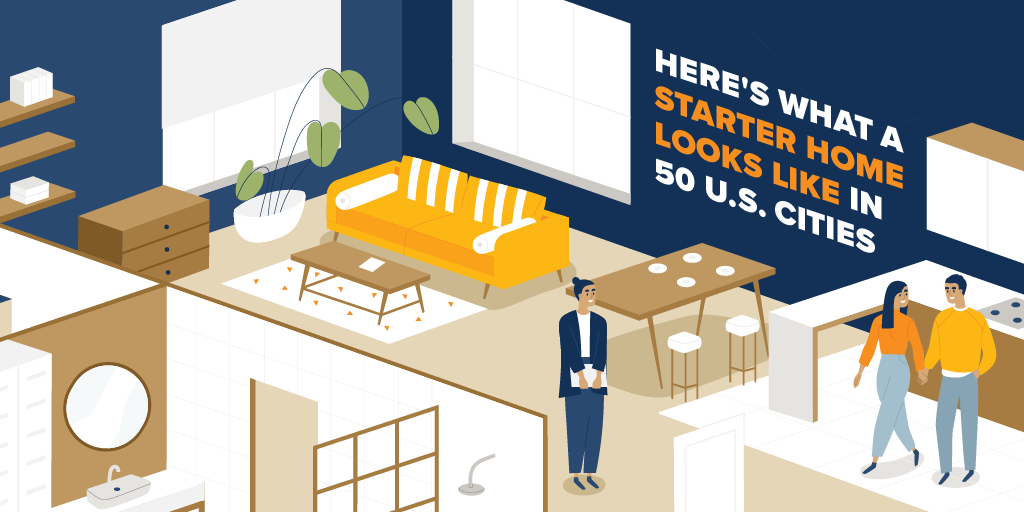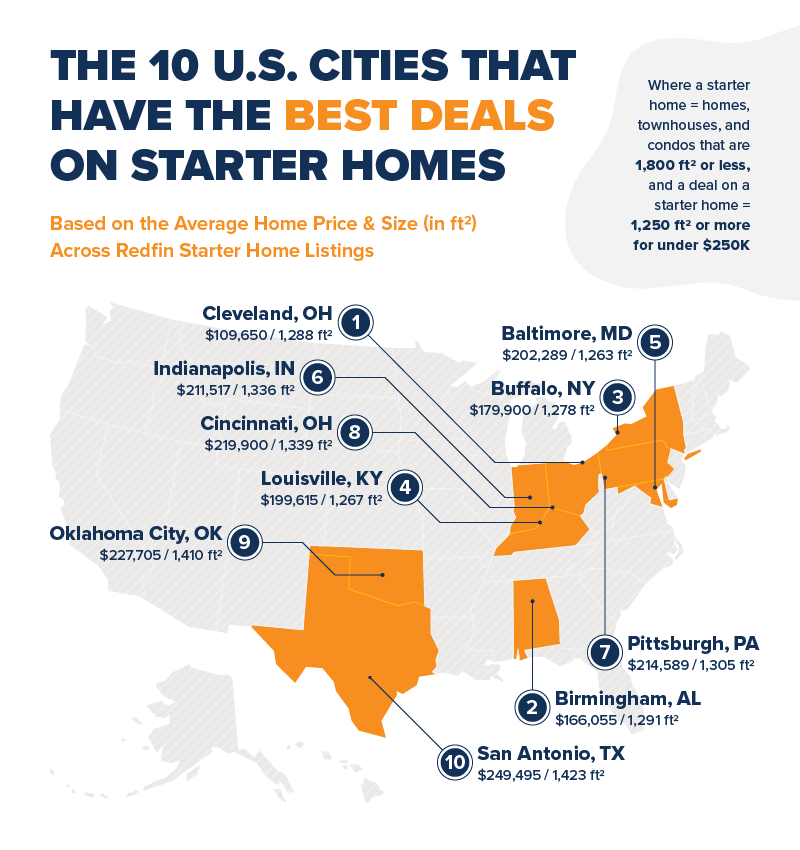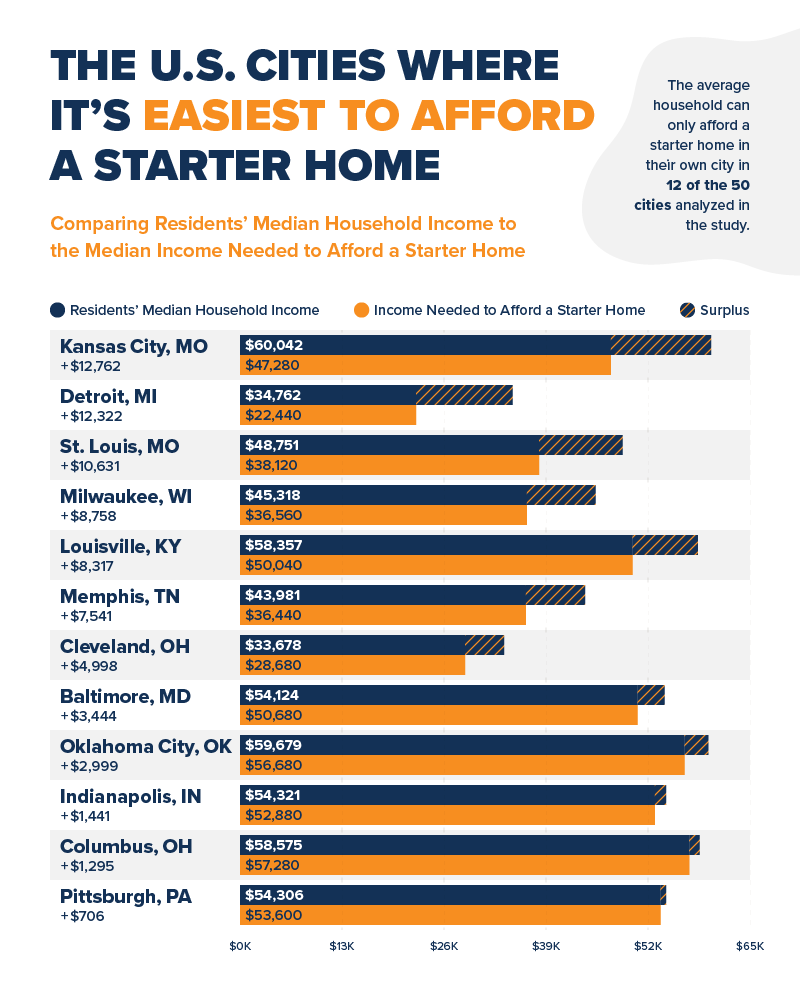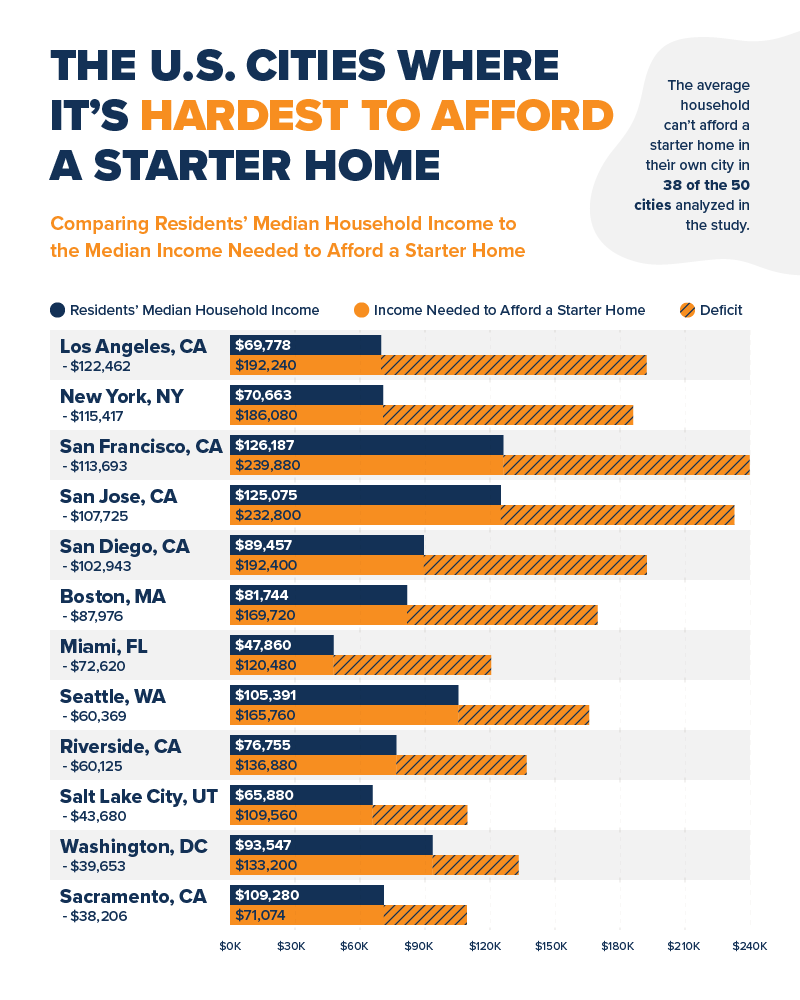Here's What a Starter Home Looks Like in Cities Around the U.S.

Buying your first home is an exciting milestone, but it's one that is becoming increasingly challenging in the U.S. With home prices soaring, the dream of homeownership might feel out of reach for many young professionals, couples, and families.
However, new house hunters shouldn't lose hope just yet.
Using data from real estate listings across 50 of the country's largest cities, we identified the cities where affordability meets quality for starter homes. From the median price to the number of bedrooms and bathrooms, we'll uncover where you can get the most house for your hard-earned money and how much you’ll need to earn annually to afford a starter home in all 50 cities.
A Blueprint of the Average U.S. Starter Home

When picturing the typical starter home in the U.S., what comes to mind? It might be a cozy three-bedroom house with a welcoming yard or perhaps a modern condo in a buzzing metropolis.
Thanks to an analysis of Redfin listings across the 50 largest U.S. cities, we have a clear picture of what a starter home looks like on average. These national figures are derived from a comprehensive look at homes, townhouses, and condos that measure 1,800 square feet or less.
So, what does the average starter home in the U.S. actually look like? Here's a snapshot:
- Average Starter Home Price: $367,677
- Average Starter Home Square Feet: 1,250
- Number of Bedrooms: 3
- Number of Bathrooms: 2
- Yard Size (in Square Feet): 6,591
- Year Built: 1969
- Price per Square Foot: $313
These numbers represent a blend of traditional homes and more urban living spaces, reflecting the diverse housing landscape that new buyers are navigating. Whether you want a small yard to grow a small garden or prioritize indoor space for hosting friends and family, this blueprint provides a starting point for what you might expect in today's market.
U.S. Cities With the Best Starter Home Deals

While the blueprint of the average starter home gives us a broad understanding of starter homes in the U.S., the landscape varies widely from city to city.
Birmingham, AL, is a hotspot for fantastic starter home deals. Here, you can purchase a nearly 1,300-square-foot home for the attractive price of just $166,055.
But the bargain doesn't stop there; starter homes in Birmingham also boast an average of 3 bedrooms, 2 bathrooms, and a generous 9,608 square feet of yard space, the second-largest average yard size in our study.
Meanwhile, in Cleveland, OH, affordability comes with a catch. You can secure a 1,288-square-foot property for just a little over $100,000. However, many of these properties are older homes that may require considerable repairs and only have one bathroom on average. The average starter home in Cleveland was constructed in 1935, making it one of the oldest on our list, along with Baltimore.
For first-time homebuyers searching for something more modern, consider looking in New Orleans, LA; Austin, TX; and Raleigh, NC. These southern cities are the three with the newest starter homes on average, with the average starter home built in 1999, 1996, and 1994, respectively.
Find starter homes with the largest square footage in Houston, TX, San Antonio, TX, and Charlotte, NC, all with average square footage of starter homes over 1,400 square feet. San Antonio, in particular, provides an attractive market for new house hunters, where they can secure a 1,423-square-foot starter home with three bedrooms for under $250,000.
The Cities Where Residents Can & Can’t Afford Starter Homes

A dream home may remain a dream if the financials don't align with reality. In the 50 major cities we analyzed, we found that the average household can afford a starter home in only 12, emphasizing the need for strategic planning and local real estate market awareness.
The 12 cities where starter homes are most attainable for the average household are:
- Kansas City, MO
- Detroit, MI
- St. Louis, MO
- Milwaukee, WI
- Louisville, KY
- Memphis, TN
- Cleveland, OH
- Baltimore, MD
- Oklahoma City, OK
- Indianapolis, IN
- Columbus, OH
- Pittsburgh, PA
Remarkably, two cities in Missouri, Kansas City and St. Louis, hold top positions as places where buying a starter home is most within reach. In these cities, the median household income aligns with the local housing market, making homeownership a more attainable goal for many young families and first-time homebuyers.
In Kansas City, MO, the median household income is $60,042, while the income needed to afford a starter home is $47,280. In St. Louis, MO, the median household income is $48,751, while the income needed to afford a starter home is $38,120. So in both cities, the median income exceeds the income required by more than 23%.
Milwaukee, WI, and Louisville, KY, round out the top five cities where starter homes are most accessible, as the median income in both exceeds the income needed to purchase a starter home by 21% and 15%, respectively.

The stark reality is that the average household can't afford a starter home in 38 of the 50 cities analyzed in our study.
For example, in Miami, FL, the challenge of homeownership is exacerbated by a significant economic divide. Despite a relatively low median household income ($47,860), the average starter home in Miami costs around $496,222; therefore, the income required to afford a starter home surpasses the median household income by 86%. The city's affluent neighborhoods drive up the average home costs, creating a housing landscape of two extremes with very few options in between.
What Does a Starter Home Look Like in 50 U.S. Cities?
Want to get an idea of what an average starter home looks like in your area? We’ve compiled our full data study for all 50 U.S. cities analyzed into the interactive data table below. Search for the city you call home, or click on the heading of each column to sort by that category!
Closing Thoughts
Buying a starter home in today's market may seem like an uphill battle, but with careful consideration and strategic planning, the dream of homeownership can still become a reality. From identifying cities where quality meets affordability to understanding the economic disparities that shape the housing landscape, these factors can help guide your home-buying journey.
But finding the right home is just the beginning.
Transforming that starter home into a place that truly reflects your style and needs is equally vital, and Five Star Painting is here to help. Painting is an easy way to enhance the aesthetics of your new home, increase its value, and provide protection against weather damage, especially if the home is an older one. Whether it's adding a splash of color to your living room or sealing the exterior to stand up against the elements, Five Star Painting can help you make the most of your new home.
Methodology
In this study, a starter home is considered a single-family home, townhouse, or condo, generally less than 1,850 square feet, as defined by the National Association of Realtors (NAR). Redfin only allows us to filter listings in 100s, so we filtered listings in each city to 1,800 square feet or less. Mobile homes, land lots, and multi-family home listings were excluded from this study.
Using Redfin listings, we scraped the average price and six other data factors––bedrooms, bathrooms, square footage, yard size, price per square foot, and year built––of starter homes across the 50 largest U.S. cities to uncover what a starter home looks like around the U.S.
Using each city’s average starter home price, we calculated the monthly mortgage payment for starter homes in each. The monthly mortgage payment includes the principal + interest, homeowner's insurance, and property taxes. The mortgage rate assumes a standard 20% down payment, a 30-year fixed loan, and the current interest rate, according to the Federal Reserve Bank of St. Louis (FRED).
Using the standard rule that monthly mortgage payments should account for no more than 30% of monthly income, we then calculated the household income needed to afford a starter home in each city. Finally, we compared the required household income to the Census median household income in each city to find where the average household could afford a starter home in 2023. The data for this study was collected in August of 2023.
 Click to call
Click to call


